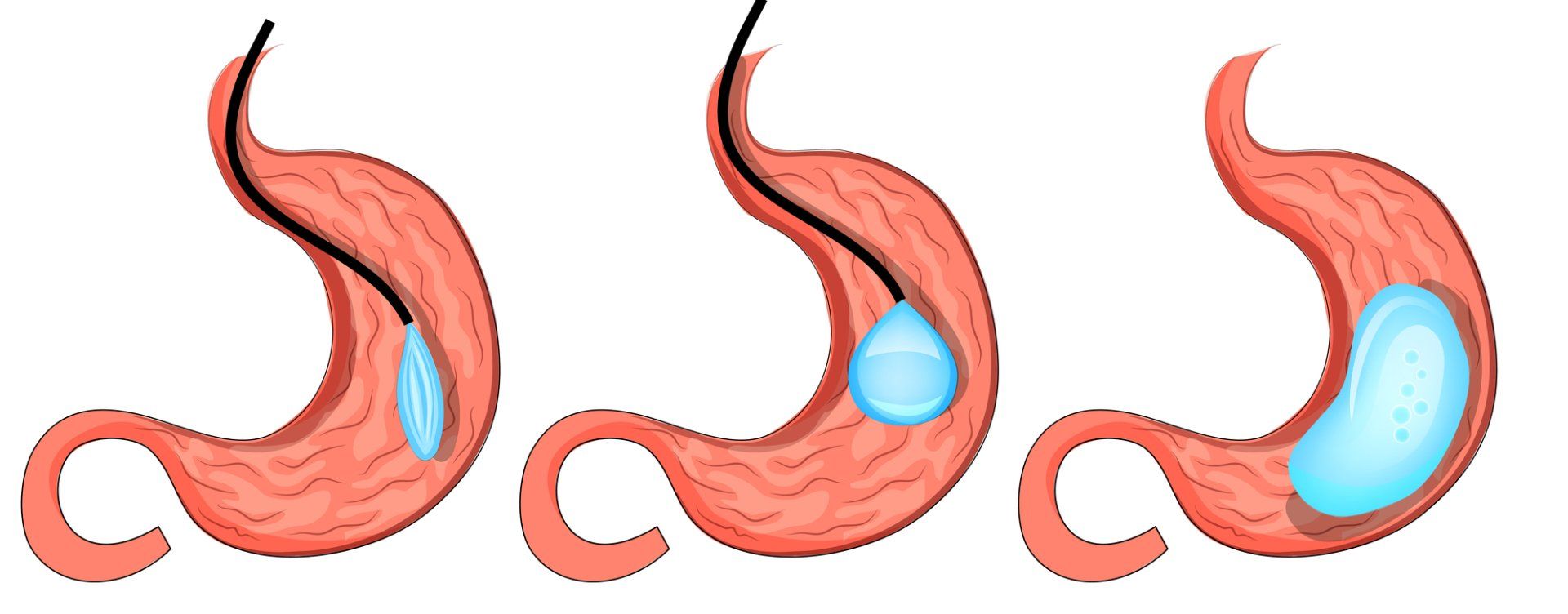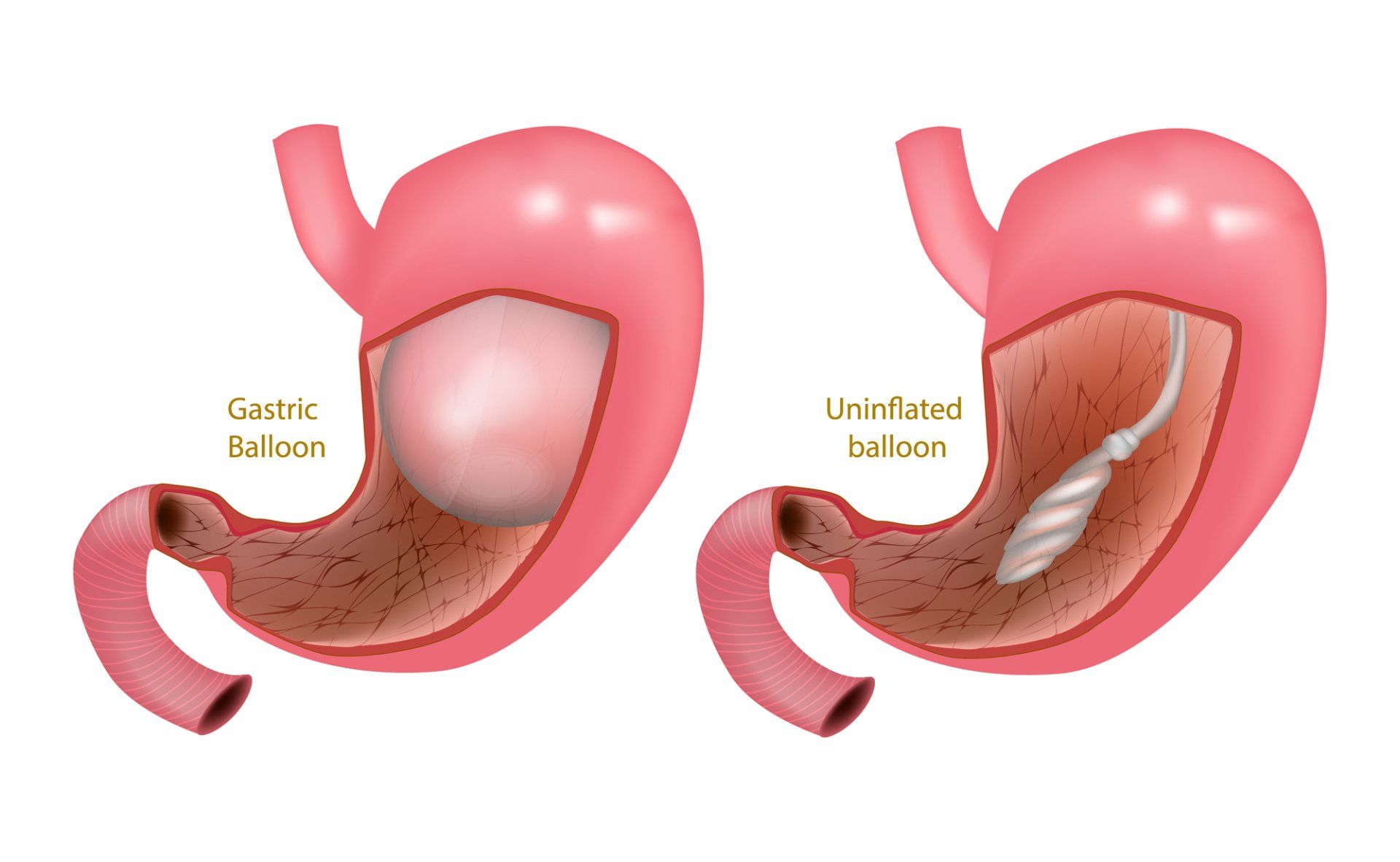Gastric Balloon (Intragastric Balloon)
The Gastric Balloon, a.k.a intragastric balloon, is a silicone balloon that is implanted into the stomach. Patients will be more inclined to smaller meals since they will feel fuller faster, leading to a reduced calorie intake. The Gastric Balloon is a pivotal addition to a holistic weight-loss regimen for patients looking to overcome obesity.
Gastric Balloon (Intragastric Balloon)
The Gastric Balloon was designed to be the cornerstone of a patient's bariatric therapy program. Dr. Michel Kahaleh is a world renowned expert on the procedure, having successfully completed over hundreds of Gastric Balloon procedures. Along with the efforts of professional nutritionists, endocrinologists and exercise therapists, Dr. Kahaleh has helped many patients successfully overcome obesity and reach their weight-loss goals.
Using minimally invasive endoscopic techniques, the Gastric Balloon is implanted into the patient's stomach. The single day procedure is conducted as an out-patient operation, with an average discharge time of just about 2 hours. After the operation, the Gastric Balloon can be utilized by the patient for up to 6 months. Once the 6 month period is completed, the balloon is then removed in an operation that is similar to the one used to implant it.
A Gastric Balloon implant has been preferred by many bariatric specialists since it gives the patient the opportunity to overcome their obesity themselves, through their own physical exercise and mental power. The procedure does not permanently alter the anatomy of the patient, by the time end of the suggested implementation period, the patient returns to a state similar to when they started. Only this time, much slimmer, having achieved their weight-loss goals.
During the patients bariatric therapy program, Dr. Michel Kahaleh will advise and assist whomever the patient’s primary bariatric physician may be. Dr. Kahaleh can also suggest a primary bariatric physician to patients who are in need of one.
Patients on average lose at least 15% of their body weight. Since the operation is minimally invasive, the recovery time from the operation is just as minimal. Meaning patients can return to their exercise therapy as soon as possible. The Gastric Balloon is intended to be a short-term solution, as after the 6 months period is over, patients will return to their regular stomach capacity.
How is the Gastric Balloon Inserted into the Stomach?
First the patient is put under anesthesia. An initial endoscopic examination is then conducted on the gastrointestinal tract. An endoscope is a long and thin flexible tube equipped with a camera at the end. This diagnostic tool allows the Dr. Michel Kahaleh to make assessments on internal organs safely and without surgery. The endoscope enters through the patient's mouth, travels through the esophagus and into the stomach.
Utilizing the endoscope, an unfilled Gastric Balloon is passed into the stomach. Once the balloon has reached its destination, saline is then filled into the balloon using the endoscope. The entire process takes no more than 30 minutes. After a suggested recovery and observation time of 2 hours is completed, the patient can return home without ever being admitted or undergoing any surgery.
How is the Gastric Balloon Removed?
Similar to the procedure used to insert the balloon, upon removal of the Gastric Balloon an endoscope is utilized. After the patient is put under anesthesia, the balloon is punctured and deflated. The endoscope will then latch onto the newly deflated balloon and then retrieve it through the mouth.
Do I Qualify for the Gastric Balloon?
The procedure for implanting a Gastric Balloon is minimally invasive, meaning that the patient will undergo little incisions and trauma to the body. So almost anyone can be a candidate for the procedure.
The ideal candidate will exhibit the following:
- A body mass index (BMI) between 30 to 40. Patients with BMIs lower or higher can be considered, with a consultation by Dr. Michel Kahaleh
- A willingness to be observed and interviews in a medically supervised program
- Previously tried to lose weight through exercise and diet without any success
How Much Weight Can I Expect to Lose with a Gastric Balloon?
The procedure itself is not intended to directly result in weight-loss by the patient, but instead be used in tandem with exercise and diet.
On average, studies have found that patients can lose on average 3x more weight when using a Gastric Balloon when compared to patients who do not use a Gastric Balloon during weight-loss therapy.
Data from clinical trials have shown that patients lose an average of 15% of their body weight after the 6 month period using the Gastric Balloon. After the Gastric Balloon is removed, patients are continually encouraged to continue with their newfound lifestyle and normalize their dietary practices and exercise.
Dr. Michel Kahaleh suggests that a target weight-loss between 20 to 40 pounds, is the most ideal and realistic for weight-loss therapies utilizing a Gastric Balloon.
Is the Gastric Balloon Safe?
Gastric Balloons are highlighted as a very-safe and reliable weight-loss therapy tool. The most severe side-effects are slight discomfort, nausea, and vomiting. These side-effects will typically last between 3 to 4 days, but it is possible for some patients to exhibit these side-effects for up to two weeks. In these cases Dr. Michel Kahaleh may be inclined to prescribe some light medication until the body has time to adjust to the Gastric Balloon.
Since the invention of the Gastric Balloon in 1985, over 280,000 patients have received a Gastric Balloon implant. It is highly regarded for its safety and reliability. As major complications are extremely rare. It is a preferred bariatric therapy procedure as it requires no surgery and is temporary. Allowing the patient to achieve their weight-loss goals by their own efforts, and once removed provides the patient with comfort knowing that their anatomy remains unchanged.
Who is Not a Candidate for a Gastric Balloon?
Some patients may not be considered a candidate for the procedure if they exhibit any of the following:
- Unwillingness to participate in a medically-supervised diet and behavior modification program
- Alcohol or drug addictions
- Variceal disease
- Active ulcers in the stomach or small intestine
- Inflammatory diseases of the gastrointestinal tract
- Daily prescribed treatment with aspirin, anti-inflammatory agents, anticoagulants or other gastric irritants
- Large hiatal hernia
- Pregnant or breast-feeding
- Heartburn symptoms despite taking heartburn medications
- Previous gastric surgery
- Prior open or laparoscopic bariatric surgery


